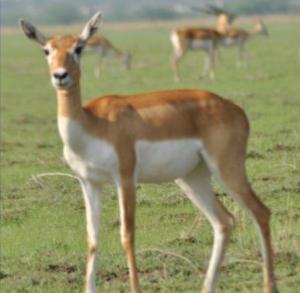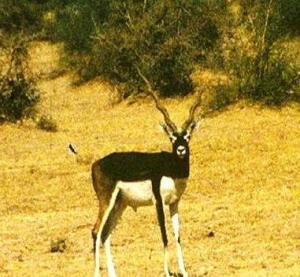Hemsingh Gehlot
To create awareness and sensibility among local communities for Blackbuck conservation which are vulnerable due to human disturbance and management practice in Western Rajasthan of India.

The Great Indian Thar Desert is situated partly in India and Pakistan. It is located in the west of Aravali range and lies between 24° and 35°5' N and 70°7' and 76°2' E. The present human population of this arid region is 22.57 million and density is 133 people per square kilometre, making the Thar one of the most densely populated deserts in the world. The climate conditions of this area is typical hot arid characterized by extreme high and low temperatures, during summer and winter respectively, and drought accompanied by high wind velocity in summer, with low relative humidity. January is the coldest month and the dry hot summer sets in after mid March which continues up to June, till the on set of the monsoon. Variation in rainfall from year to year is wide and failure of monsoon is quite frequent.

The Thar Desert is supported with good numbers of trees and shrub species. The thorny type of vegetation is the most dominant. It consists of three series, namely, (i) Calligonum polygonoides-Clerodendrum phlomidis (ii) Prosopis-Capparis-Ziziphus and (iii) Acacia-Capparis. Over the last 30 years, the prime Desert areas have been transformed for extensive agriculture thus destroying valuable biodiversity of this unique biome. The wildlife surviving in extant patches of Desert grassland is still under great pressure due to variety of reasons. Grassland obligate species like Wolf (Canis lupus), Caracal (Caracal caracal), Desert cat (Felis sylvestris), Desert fox (Vulpes vulpes pusilla), Chinkara (Gazella bennetti), Blackbuck (Antelope cervicapra) and Great Indian Bustard (Ardeotis nigriceps) are highly endangered species of the Desert Landscape, but till now no conservation strategy has been developed for these animals within this unique landscape.
Despite its harsh environmental conditions, the Rajasthan Desert has been supporting a large number of wild animals among the wild ungulates of this desert, The Indian antelope (Antelope cervicapra) and the Indian gazelle (Gazella bennetti) are the predominant species. Indian Blackbuck (Antelope cervicapra) a globally near threatened ungulate had once a wide distribution in Thar Desert of Rajasthan, India but during the last three decades illegal poaching, land use changes, escalation of human and livestock population, increasing domestic dogs and development activities have resulted into a total transformation of the Thar scenario and wildlife numbers have rapidly declined.
Indian antelope population dynamics in relation to habitat variation inside the Rajasthan and as a consequence Rajasthan having at least 60 % of the whole population of Blackbuck in India. Due to habitat destruction this species is listed endangered under schedule I of the Wildlife Protection Act of India, 1972 and in Appendix II of CITES and included Vulnerable as per Red Data Book (1994). The main aim of project is find out the present distribution of blackbuck in western Rajasthan and to aware local communities for Blackbuck conservation in and out side the protected areas through organize workshops at village level with collaboration of forest department, engage villagers & students for a long-term monitoring of endangered species Blackbuck and other Thar wildlife.
During project duration, students, local NGOs, village community groups and forest department staff will be trained and later involved in the monitoring. They will be taken into confidence and a network of people formed, that will help in long term monitoring of Blackbucks beyond the project duration in Thar Desert of Rajasthan.